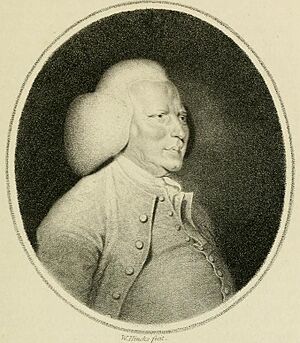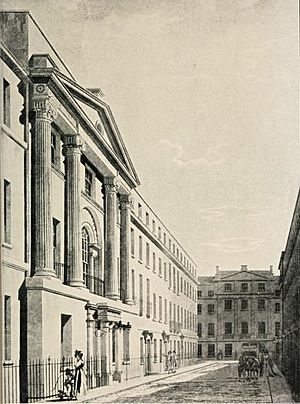William Shipley facts for kids
William Shipley (born 1715 – died 1803) was an English drawing teacher, social reformer, and inventor. In 1754, he started an arts society in London that later became known as the Royal Society of Arts (RSA). This society helped encourage new ideas in arts, manufacturing, and trade.
Contents
Life
Early Years and Training
William Shipley was born in Maidstone, Kent. His father died when William was only three years old. He then went to live with his grandfather.
When he was 21, William received some money. He used it to become a painter and drawing teacher in Northampton. While there, he joined a local society. He started his work helping others by raising money to buy fuel for people in need.
Around 1750, Shipley moved to London. He opened a drawing school in the Strand area. This school was very successful. Some of his students became famous artists, including Richard Cosway and Thomas Jones.
The Society of Arts
The idea for the "Society for the Encouragement of Arts, Manufactures, and Commerce" came from Shipley's school. In 1753, he shared his plans for the society. He hoped it would make Great Britain a leader in arts and sciences.
The first meeting of the society was on March 22, 1754. It took place at a coffee house in Covent Garden. Important people like Viscount Folkestone were among the first members.
In 1755, Shipley's plan for the society was published. It said the society would "promote the arts, manufactures, and commerce" of the country. They would do this by giving awards for useful inventions and discoveries.
The society offered prizes for many things. For example, they gave awards for finding cobalt and growing madder. These were important for Britain's textile industry. Cobalt makes a bright blue dye, and madder was the main source of red dyes. The society wanted Britain to be able to dye its own cloth.
The Society also worked to solve the problem of finding enough wood for building ships. This was important for Britain's defense. They offered prizes for growing trees like oaks and elms. They even offered a prize to anyone who could find a way to transport breadfruit from the East to the West Indies.
Shipley also encouraged people to make better maps. He gave special prizes to encourage exploration. Shipley's work through the Society greatly helped England's economy and safety.
Inventor and Later Years
Shipley became a "perpetual member" of the society in 1755. He received a gold medal from them in 1758. He later left his job as registrar in 1760.
In 1767, William Shipley married Elizabeth Miller. He moved back to Maidstone around 1768. In Maidstone, Shipley started another local group. This group was similar to the Society of Arts. In 1783, this group helped improve conditions at Maidstone prison. This helped prevent illnesses from spreading among the prisoners.
Shipley was also an inventor himself. He had ideas for cheap fuel for the poor. He also designed a floating light to help save people lost at sea. He even thought of a way to line shoes with tinfoil to keep them dry.
William Shipley died in Maidstone in 1803, at the age of 89. A monument was built for him at All Saints Church, Maidstone.
Legacy
Historians say that Shipley's life was important. He lived during a time when England's trade grew strong. He also saw the start of the Industrial Revolution. This was when new machines like the steam engine changed how things were made.
Many people believe Shipley helped create the idea of private groups helping the public. At the time, the government was busy with wars and money. It did not have many resources to help with culture or new ideas. The Society of Arts showed how much private groups could do.
The William Shipley Group for RSA History is named after him.
Students of Shipley's Art School
- William Hodges
- Francis Wheatley
- Richard Cosway
- William Pars
- Thomas Jones
Fellows of RSA with Shipley




